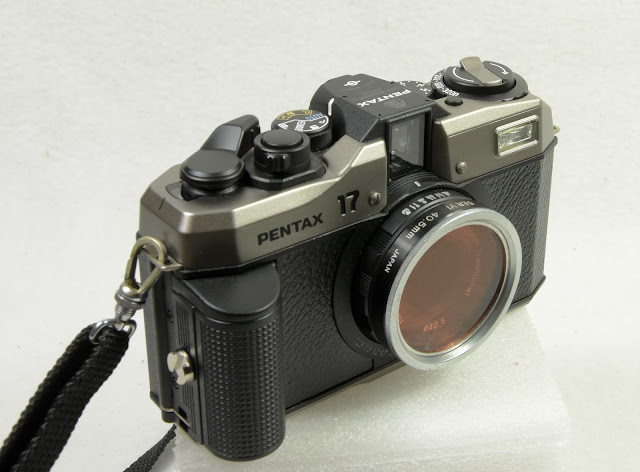 |
| The Pentax 17 with an 85b filter |
About a month ago, I purchased a new Pentax 17 half-frame camera. While it does have its peculiarities, I enjoy shooting with it, and hope to do a full review of it soon. One of the peculiar things about it is the 40.5mm diameter for a threaded filter. While not a common thread size in most cameras, it is shared by Leica and some other 35mm rangefinder lenses. There are a couple of ways to go with using filters on the Pentax 17, and since the light sensor is next to the lens, it will include the filter in its exposure calculation. You can attach filters on the Pentax 17 a few different ways as follows:
- Purchase a set of 40.5mm filters - which can be pricey
- Buy a 40.5 to 49mm step up filter adapter, allowing use of readily obtainable 49mm filters
- Buy a 40.5mm to Series VI filter adapter.
- Tape a bigger filter over the lens - works, but looks like shit.
 |
| Series 6 filter unit |
Options 2 and 3 are the best, in my opinion. If you already have some Series 6 filters, all the better. It just so happens that I already had the 40.5mm to Series 6 adapter, and me, being the old guy with all the old stuff, I have a shoebox full of Series 6 filters and assorted adapters. So, I put together a kit with Series 6 filters, which include:
- Red 25A filter
- Yellow K-2 filter
- 85B warming filter
- Polarizing filter
 |
| Series 6 filters, with the adapter retaining ring on the left, and the adapter base on the right |
The beauty of Series filters is that you can also use gels or other circular materials to create filters - or a piece of window screen, plastic wrap, or other material to provide a special filter effect. Series filters consist of a screw-in adapter (or a push-on adapter for some older lenses without screw threads), and a screw-in retaining ring that holds the screw-less filter in place. No one is making Series filters today, but they are easily found on eBay as well as your traditional old camera store - in the junk boxes.
 |
| The light sensor is above the lens, but within the filter ring. |
Why would I want to use a filter?
If one is using black and white panchromatic (full-spectrum sensitivity) film, using a colored filter can open up your creativity. With some films that are more sensitive to the red end of the spectrum - as in near infrared, a deep red filter will give you the "Wood effect" which is when leaves and other surfaces reflecting infrared look a ghostly white with deep black skies. I've not tested the Pentax 17 with near-infrared films, but it might be able to use something like the Ilford SFX 200 with a red 25A filter. Since the camera is auto-exposure, using an R72 deep IR filter is out of the question.
In more typical panchromatic films, a red filter really darkens the skies and gives clouds more contrast. An orange filter also does that without as extreme a result, and a yellow filter is that sweet spot of enhancing tonality in landscapes as well as every-day photography.
Okay, I listed the 85b warming filter, so why would I use it with b&w film? My fellow photographer, Russell Young, got this tip from the great Laura Gilpin. Using an 85b filter with panchromatic b&w film subtly renders better contrast in many subjects, and also gives wonderful skin tones to most subjects. It's especially valuable using it in the skies of the West. I've been using such a filter a lot in the past few months, and I do think it enhances the images. So, give it a try.
Using a polarizer without seeing its effect in the viewfinder may seem like a bad idea, but in reality, it's great to use to reduce reflection from shiny surfaces and also as a kind of neutral-density filter.
Neutral-density (ND) filters are helpful if you want to use higher ISO films to create slow-moving effects, such as waterfalls. The slowest shutter speed on the Pentax 17 is 4 seconds, as well as B. So, using an ISO 50 or 80 film with an ND filter should give you good results if you want that silky waterfall look.
As far as filters for color film, you could use the 85b with any Tungsten film (such as Kodak Vision 200T) in daylight, providing more natural color. In addition, the polarizer and ND filters could also be used. Hey, you have a lot more exposures per roll with the Pentax 17, so feel free to experiment!
 |
| K&F Concept 40.5 to 49mm filter adapter |
 |
| the 49mm filter will obscure part of the viewfinder |


































